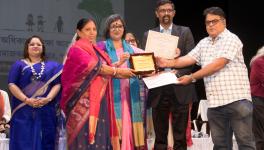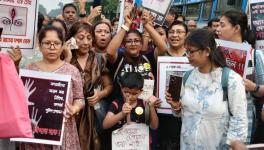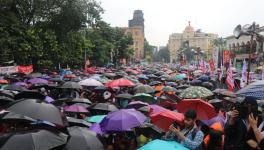East-West Metro: Truth Behind Mamata Govt's Propaganda
Representational use only.Image Courtesy: Wikimedia
West Bengal Chief Minister Mamata Banerjee and her administration’s policy has been to appropriate many of the achievements of the Left Front regime and publicise them to make people believe that those were done in the past 11 years of the Trinamool Congress government. This is similar to what Uttar Pradesh Chief Minister Yogi Adityanath does.
There are several examples of such moves by the TMC government. In 2017, when Yuva Bharati Krirangan, popularly known as the Salt Lake Stadium, was renovated for the U-17 football world cup, the plaque bearing the name of late Chief Minister, Jyoti Basu, was removed and replaced with a plaque bearing the name of Mamata Banerjee. However, the foundation stone of the stadium was laid by Left Front Chief Minister Jyoti Basu way back in 1981 and the stadium was completed in 1984.
There are several other instances where the TMC government has tried to obliterate the achievements of the previous Left Front government and re-write history. The East-West Metro Corridor is another project that the TMC is trying very hard to advertise as Banerjee’s brainchild. The truth, once again, is far from what is being claimed.
Back in 2009, on February 22, Left Front Chief Minister Buddhadeb Bhattacharjee, had laid the foundation stone of the East West Metro project. The programme was attended by then External Affairs Minister of UPA I government, Pranab Mukherjee. It was then a joint venture between the central and the state governments and not a project of the Railway Ministry, as is being claimed by the TMC minister and Mayor of Kolkata, Firhad Hakim.
Banerjee, had, in fact, tried to create as many impediments as she possibly could to stall the construction of the corridor back then. A few days before laying of the foundation stone, she tried to pressurise the UPA I government to back out of the project. She had famously said that the central government should not give any money to the debt-laden state government and that the former should stop backing the Left Front government. This was ahead of the Lok Sabha votes at the time.
TMC, then an opposition party in the state, had shown black flags to Bhattacharjee while he was on his way to the foundation stone laying ceremony. A couple of hours after the ceremony, Partha Chatterjee, a key leader of the TMC, addressed a press conference at Banerjee’s instructions. There, he described Pranab Mukherjee as CPI(M) ’s boot-licking hero of Bengal.
The whole episode was indecorous and infuriated Mukherjee to an extent where he was forced to make a statement in which he said, in a poor country like India, embarking upon any development project is dotted with obstacles. “We are faced with paucity of funds and lack technical know-how. And if to all this, if self-made hindrances are inflicted, nothing can be more unfortunate,” he said.
From the podium of the ceremony, the then CM Bhattacharya had announced that the metro project would commence from Howrah Maidan and traverse under River Ganga (the first underwater train line in India) to reach Bidhannagar Sector V, via Sealdah, and the project would be completed by 2014.
A project that was supposed to be completed by 2014 is only partially finished eight years later. The incidents responsible for this unconscionable delay are disgusting, to say it mildly. A few weeks after the foundation stone was laid for the ambitious project, Banerjee was inducted as the Railway Minister of the UPA II government. After swearing in as the minister, she went on to use her authority to thwart the plan of constructing stations at Howrah and Sealdah, knowing fully well that these two stations were vital for the project to benefit the passengers.
To avoid further conflict and smoothen the path of successful completion of the project, the then state government decided to hand over the project to the Union Railway Ministry. This decision was taken keeping in mind the benefits that the passengers would enjoy once the corridor was completed.
Instead of unwrinkling the process of construction, this transfer to the Railway Ministry, in reality, pushed the project deep into an abyss of mismanagement and corruption. To safeguard the interests of some businessmen and land sharks, the sanctioned route of the corridor was changed by the Mamata Banerjee government in 2012 after the TMC came to power. A realigned route was initially opposed by the then Union Ministry of Urban Development, the nodal Kolkata Metro Rail Corporation Ltd (KMRCL), and funding partner Japan International Cooperation Agency (JICA) over cost overruns, unforeseen delays and probable subsidence.
This erroneous decision of realigning the previously sanctioned route has led to substantial cost overruns, and the project has so far missed six deadlines.
Taking this opportunity, one can look back at 2009 when, after ascending the chair of the Union Railway Minister, Banerjee inaugurated the extended metro rail project connecting Tollygunge to Garia, where she had invited then governor of West Bengal Gopalkrishna Gandhi. But Bhattacharjee, who was the Chief Minister at the time, was not invited.
Further, this project was not solely under the Railway Ministry. The then Left Front government had borne 30% of its total cost.
This attempt to wipe out the achievements and contributions of the Left Front government and re-write history will not go down well with the ordinary people of West Bengal.
Author is a social activist based in Kolkata. Views are personal.
Get the latest reports & analysis with people's perspective on Protests, movements & deep analytical videos, discussions of the current affairs in your Telegram app. Subscribe to NewsClick's Telegram channel & get Real-Time updates on stories, as they get published on our website.
























